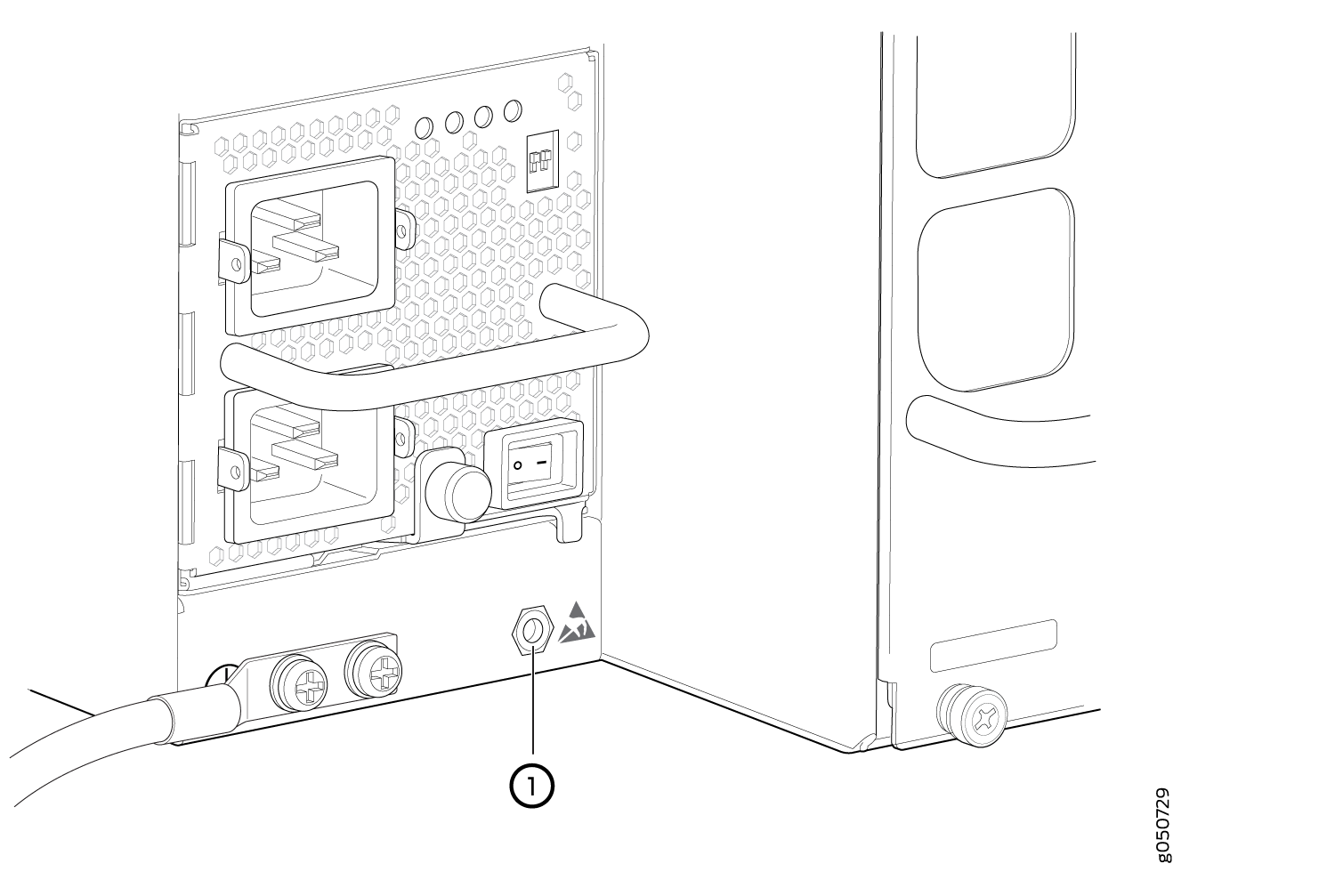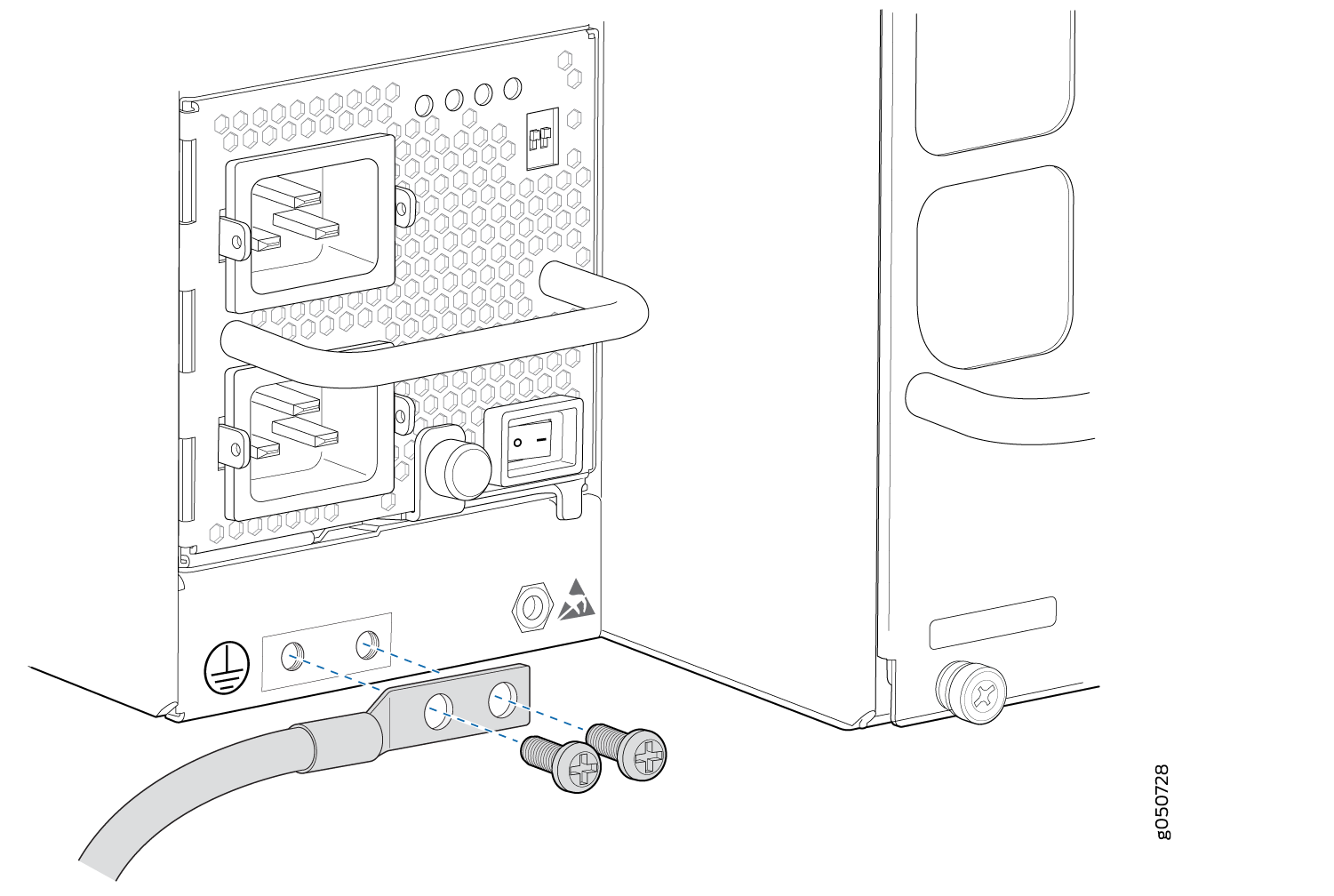Connect the PTX10016 Router to Power
PTX10016 routers support AC, DC, high-voltage alternating current (HVAC), and high-voltage direct current (HVDC) power supplies. To connect power to a PTX10016 router, read the following procedures in this topic.
Do not mix power supply models in the same chassis in a running environment. DC and HVDC can coexist in the same chassis during the hot swap of DC for HVDC.
Connect the PTX10016 Router to Earth Ground
To meet safety and electromagnetic interference (EMI) requirements and to ensure proper operation, you must connect the chassis to earth ground before you connect it to power.
You must install the PTX10016 router in a restricted-access location. You must ensure that the chassis is always properly grounded. The PTX10016 router has a two-hole protective earthing terminal provided on the chassis. See Figure 2. Under all circumstances, use this grounding connection to ground the chassis. For AC-powered systems, you must also use the grounding wire in the AC power cord along with the two-hole grounding lug connection. This tested system meets or exceeds all applicable EMC regulatory requirements with the two-hole protective earthing terminal.
Ensure that a licensed electrician has attached an appropriate grounding lug to the grounding cable you supply. Using a grounding cable with an incorrectly attached lug can damage the router.
Mount your router in the rack before attaching the grounding lug to the router. See Mount the PTX10016 by Using the EX-MOD-RMK-4POST Rack Mount Kit.
Ensure that you have the following parts and tools available:
An electrostatic discharge (ESD) grounding strap (provided in the accessory kit).
Protective earthing terminal lug (provided).
Grounding cable for your PTX10016 (not provided)—The grounding cable must be 6 AWG (13.3 mm²), minimum 90°C wire, or as permitted by the local code.
Grounding lug for your grounding cable (provided)—This bracket attaches to the lower left corner of the router chassis next to the bottom power supply, providing a protective earthing terminal for the router. The grounding lug required is a Panduit LCD6-10A-L or equivalent.
A Phillips screwdriver (not provided) to tighten the two screws that are mounted on the chassis.
The terminal lugs that we provide for the JNP10K-PWR-DC2 are Panduit LCD4-14A-L, or equivalent, and sized for 4 AWG (21.1 mm2) power source cables. The 4 AWG (21.1 mm2) stranded wire should be rated 75° C, or per local electrical code. When using all JNP10K-PWR-DC power supply modules in the chassis, the DC power source cables that you provide must be 6 AWG (13.3 mm²) stranded wire. We recommend that you install heat-shrink tubing insulation around the crimped section of the power cables and lugs.
An AC-powered PTX10016 gets additional grounding when you plug the power supply in the router into a grounded AC power outlet by using an AC power cord appropriate for your geographical location. See PTX10016 Power Cables Specifications.
To connect earth ground to a PTX10016 chassis:
Connect AC Power to the PTX10016 Router
Before you begin to connect power to the router, be sure you understand how to prevent ESD damage. See Prevention of Electrostatic Discharge Damage.
After you ground the chassis, add power supplies, and supply power to the chassis, the system initiates the power-on sequence. This sequence can start incrementally with a single power supply, but we do not recommend that you bring a PTX10016 system up with less than three power supplies.
To connect AC power to a PTX10016 chassis:
See Also
Connect DC Power to the PTX10016 Router
Before you begin to connect power to the router, be sure you understand how to prevent electrostatic discharge (ESD) damage. See Prevention of Electrostatic Discharge Damage.
The procedure to bring up a DC-powered chassis involves the proper cabling of the individual power supplies, adding the power supplies to the chassis, and supplying power. The power-on sequence can start incrementally with a single power supply, but it is not recommended that you bring a PTX10016 system up with less than three power supplies.
You must connect each power supply input feed to a dedicated DC power source outlet.
To connect DC power to the PTX10016 chassis:


